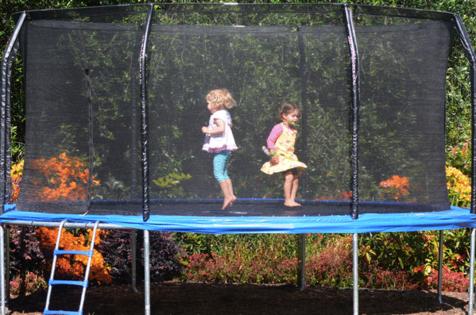Ask the Pediatrician: Are trampolines safe for kids?
Published in Health & Fitness
Generations of kids have grown up bouncing on backyard trampolines. And with the new popularity of trampoline parks, even more are getting into the game.
But is this a safe way for kids to move their bodies and have fun? There is a lot to consider before letting your kid head out to bounce with the neighborhood kids or attend a birthday party at a trampoline park.
Why are pediatricians concerned about trampolines?
More than 800,000 children got hurt on trampolines between 2009 and 2018, research shows. While bumps and bruises are super common injuries from trampolines, we often see kids suffer broken bones or sprains as a result of falls on the mat or off the trampoline.
It is easy to assume that these injuries are not a big deal. After all, most sprains or broken bones heal, right? But trampolines pose incredibly high risks for serious injuries.
Examples of serious trampoline injuries include breaks to bones or injuries to ligaments that require surgery, paralysis and even life-threatening injuries. And even broken bones can leave kids with lasting effects including the potential for nerve damage.
These facts explain why the American Academy of Pediatrics recommends keeping kids away from trampolines, except in settings with professional coaches and specialized equipment.
Many kids who get hurt on trampolines only suffer small scrapes, bruises or cuts. But of the 110,000 or so emergency room visits linked with trampoline accidents in the U.S. each year, thousands involve serious damage to a child's arms, legs, collarbone, back or neck.
Concussions are another common injury from collisions on trampolines. These are brain injuries that can cause kids to suffer headaches, dizziness, nausea and other symptoms. Concussions can also affect their sleep, thinking and school performance
Kids typically get injured on trampolines when they:
Are the smallest kid on the jumping surface
Collide with others jumping at the same time
Land wrong on the trampoline surface
Accidentally fall from the surface to the ground
Get into a "double bounce," where one jumper lands and sends another into the air
Try risky moves such as flips and somersaults
Fall on the springs, hooks or frame
Bounce parks are incredibly popular these days. In a spacious trampoline park, the jumping surfaces are bigger and bouncier—and many more bodies share the same areas. This increases the odds of severe injury when compared to home trampolines.
Jumpers may bounce from mat to mat in an unpredictable way that increases the chances of collisions. The bouncier mats also allow jumpers to go higher and this increases the risk of injury as they then land with greater force on the mat.
One study found that 11% of jumpers at 18 different trampoline parks suffered serious injuries. Another showed that people hurt in bounce parks are twice as likely to need surgery than those hurt in other settings.
What can I do to protect my child?
First, it is important to understand the risk associated with playing on a trampoline. Because toddlers and preschoolers face the greatest risks for trampoline injuries, kids under 6 should NEVER jump. The AAP recommends that kids of all ages avoid trampolines—but if you decide to let older children jump, make sure they follow these common-sense rules.
Only one child jumps at a time.
There's always a grownup watching.
No flips or somersaults, since these cause the most serious neck, head and back injuries.
No jumping from rooftops or other high places onto the trampoline.
The safety net around the jumping surface stays zipped shut while they jump.
The ladder comes down when no one's bouncing so that little kids can't climb up alone.
If you decide to get a home trampoline, install the bouncing surface as close to the ground as possible. Position it far away from trees, walls, buildings and other play areas. Every time your kids jump, check the protective pads that surround springs, hooks, support bars and other hard surfaces. Look closely at the safety net for tears, holes or seams that have come apart. Replace worn nets, pads and other safety elements before you allow kids back on the trampoline. Check your homeowner's insurance for coverage of trampoline-related injuries. (Many policies will not pay when jumpers get hurt.)
If your child wants to try the trampoline park, wait until they're at least 6 years old. Even spaces that seem safe—for example, bouncy houses and foam pits—can be dangerous for little ones.
Read the waiver and understand the risks and what activities are allowed and not allowed at the trampoline park.
Avoid traditionally busy hours of the day. Go when it is less crowded.
Stick close to your child. There's less chance they'll make extreme moves with your eyes on them.
Remind them that the jumping surfaces are bouncier and harder than a backyard trampoline. Encourage them to test things out before they go all-in. Make sure they keep their eyes open and try to avoid collisions.
What about supervised gym and school programs with trampolines?
Every athletic activity carries some risk of injury, and trampoline programs are no exception. However, jumping under the supervision of a trained coach or instructor is very different from bouncing in the backyard or visiting a trampoline park.
Athletic staff generally work within safety rules and inspect equipment often. They may use a special harness to help kids learn specific moves (or simply protect their growing bodies). For these reasons, you may feel more comfortable allowing your child to try out a gymnastics, dance or other program that includes trampoline work.
____
About Dr. Briskin
Susannah M. Briskin, MD, FAAP, is a member of the AAP Council on Sports Medicine & Fitness and Section on Orthopaedics. She is a Professor of Pediatrics in the Division of Pediatric Sports Medicine at Rainbow Babies and Children’s Hospital in Cleveland, Ohio.
©2024 Tribune Content Agency, LLC.










Comments